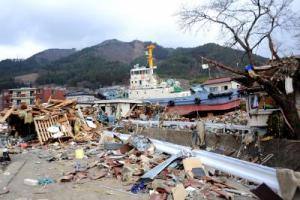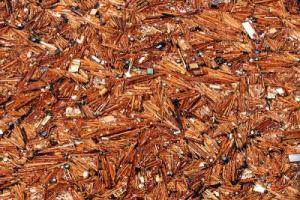On science blogs this week: Quake
IN JAPAN: THE EARTHQUAKE, THE TSUNAMI, AND THE NUCLEAR THREAT. Is there any other topic this week except the trifecta of tsouris that has descended on the Japanese: the giant earthquake, the subsequent unprecedented tsunami, and a nuclear disaster second only to Chernobyl?
All the major science outlets are publishing heavily on this topic. Here's a tiny rundown of selected blogging, but there's plenty more .
At Science, ScienceInsider rounded up all earthquake-related items, including a Q&A series. Nature's Great Beyond, a group blog about news, has several posts, but doesn't seem to be collecting them under a single topic heading. So you'll have to go to The Great Beyond home page and scroll down to see the assortment.
Scientific American has a list of earthquake-related Twitter conversations at Observations, its blog by SciAm editors. Its guest blogs offer other observations. Chris Rowan has written a basic Explainer with maps and other graphics. Charles Choi reflects on Chernobyl. Bora Zivkovic pooh-poohs the widespread folk notion that animals (and some people) possess a sixth sense that can forecast disasters. Bering in Mind reflects on why people believe disasters like the Japanese earthquake and tsunami are metaphysical signs or portents, messages from on high expressing disapproval of some human behavior. And then there's unreasoning nuclear fear. SciAm has also set up a roundup page that provides links to blogs and much other material.
If it's news articles you're after, Charlie Petit has collected scores from around the world, including Japan, in daily posts all this week at the Knight Science Journalism Tracker. There's no all-encompassing roundup, but go to the KSJT home page and scroll down to find the earthquake-related collections. There's a Spanish-language post there too, and an English-language post about the German press, where there's been enormous concern about nuclear issues and radiation.
At C&ENtral Science, Rudy Baum posts a video explaining the nuclear reactor emergency by Martyn Poliakoff, a chemistry professor at the University of Nottingham, in the U.K
The tsunami wreaked unimaginable havoc in Japan, but it had impacts far away too. Southern Fried Scientist, a grad student, reports tsunami damage to the Charles Darwin research station in the Galapagos.
Finally, John Timmer at Nobel Intent attempts a careful, panic-free description of what's really gone on in the Japanese nuclear reactors. On Thursday evening, March 17, he forewent green beer to summarize thus:
At best, even those present at the site have a limited view of what's going on inside the reactors themselves, and the situation has changed rapidly over the last several days. Meanwhile, the terminology involved is somewhat confusing – some fuel rods have almost certainly melted, but we have not seen a meltdown; radioactive material has been released from the reactors, but the radioactive fuel currently remains contained.
HEALTH BLOGGING ABOUT THE TOHOKU EVENT. Eventually writers on health topics will no doubt turn to the other bodily effects of what is now being called the Tohoku Event, and we will learn what other plagues can befall people who've already been knocked off their pins by earthquakes and a tsunami almost too big to contemplate. But for the moment, despite reassurances like Timmer's (above), health writers are focusing on the potential for radiation effects.
Find several posts at the Harvard Health Blog – focused, of course, on radiation dangers, especially radioactive iodine and the use of potassium iodide for pretty ineffective prevention of thyroid cancer. At the Wall Street Journal Health Blog, Katherine Hobson describes radiation exposure risks for the pregnant.
At Bad Astronomy, Phil Plait ridicules homeopathic remedies for radiation sickness, which include, of all things, X-rays.
At Shots, the NPR health blog, Richard Knox reassures us that radiation decontamination is simpler than we might think. Several other earthquake-related posts are at Shots, too. Find them by scrolling down the home page. Also at NPR, Marcelo Gleiser tackles earthquake consequences you didn't know about at the 13.7 blog. For example, earthquakes shorten day length, and this one shifted the position of Japan's main island by 8 feet.
There's frustration with the lack of reliable data. At the Columbia Journalism Review's Observatory blog, Curtis Brainard talks about what a difficult time journalists are having with getting trustworthy information. A main thrust of his piece, though, is to refute the Wall Street Journal's charge that journalists are focusing on the (relatively) small risk of radiation exposure and neglecting the enormous lethal damage so widely imposed by the quake itself and subsequent tsunami.
ON THE UTILITY OF CHANGING THE SUBJECT. At Mind Hacks, neuroscientist Vaughan Bell describes the new view of post-disaster counseling. Not everybody needs it, and it can even be damaging. Bell notes:
studies suggested that this was at best useless and instead probably made mental disorders more likely – probably because it raises or extends the level of stress in already very stressed people. Perhaps unsurprisingly, most disaster victims are not that interested in exploring their emotions but want to get to a safe place, find out how there friends and family are, and solve immediate practical problems. This in itself tends to make people feel better.
At Medical Lessons, oncologist Elaine Schattner muses on images from Japan, Susan Sontag's book Regarding the Pain of Others, and why we watch. Or don't. Sontag writes:
People can turn off not just because a steady diet of images of violence has made them indifferent but because they are afraid.
HOW AND WHY TO BLOG. So here I am, turning off and changing the subject. In January the New England Science Writers pulled together a terrific panel on blogging, featuring some of our science writing stars: Daniel Carlat, Ivan Oransky, Alison Bass, Gary Schwitzer, and Rachel Zimmerman. The session was recorded, and the video is now available to you all for free online, thanks in part to some funding from your host, the National Association of Science Writers. Find a description of the session here and the video, which runs for about an hour and a half, here at MIT's TechTV.
In addition to the NESW session on blogging, we also underwrote recording of several sessions at the ScienceOnline2011 meeting in January at the Research Triangle in North Carolina. The SciO11 sessions finally have been archived online and are now available to you, also free. Find the links here.
A couple of comments about the SciO11 videos. First, AAAS also funded some of the sessions. So not all are aimed at science writers. The SciO11 meeting itself comprised both writers and actual scientists (although of course they are writers too, since they blog.) But a session on using blogging to help you get tenure may not be the professional help you were hoping for.
Second, sound and picture quality in the SciO11 sessions is, um, variable. By contrast, the part of the NESW blogging meeting I watched was technically pretty good.
NASW is planning to do more of this recording of local meetings useful to science writers and getting the recordings online and available everywhere at no charge. We are learning as we go and striving to emphasize improving quality of sound and video. Find information about how to apply to NASW for money to do something like this here.


